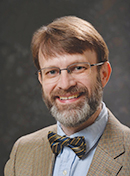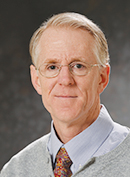News
2013 Technical Excellence Award Recipients
Dr. Jeremy Kepner
 For his leadership and vision in bringing supercomputing to Lincoln Laboratory through the establishment of LLGrid; his pivotal role in open systems for embedded computing; his creativity in developing a novel database management language and schema; and his contributions to the field of graph analytics.
For his leadership and vision in bringing supercomputing to Lincoln Laboratory through the establishment of LLGrid; his pivotal role in open systems for embedded computing; his creativity in developing a novel database management language and schema; and his contributions to the field of graph analytics.
Dr. Jeremy Kepner is a senior staff member in the Computing and Analytics Group at Lincoln Laboratory. Currently, he is engaged in programs involving supercomputing, embedded computing, big data, and graph analytics. After joining the Laboratory in 1998, he worked on various high performance embedded computing projects. He led the Department of Defense (DoD) High Performance Embedded Computing Software Initiative that created the Vector, Signal, and Image Processing Library standard used in many DoD sensor systems, and directed the development of the Parallel Vector Tile Optimizing Library, which earned a 2011 R&D 100 Award. From 2001 to 2011, he was technical chair of the Laboratory's High Performance Embedded Computing Workshop, and since 2012 has chaired the IEEE High Performance Extreme Computing Conference, now the largest computing conference in New England.
From 2001 to 2005, Dr. Kepner led the DARPA High Productivity Computing Systems government team that developed the benchmarks used to validate most supercomputers today. He invented MatlabMPI software and was the architect of pMatlab (Parallel Matlab Toolbox) used by 100s of Lincoln Laboratory staff and 10,000s of scientists and engineers worldwide. This software became the foundation of the Lincoln Laboratory Grid (LLGrid) program that provides supercomputing capabilities to all of Lincoln Laboratory. He served as principal investigator on two DoD projects that provided the hardware for LLGrid, and led efforts to create successive data centers to house the LLGrid equipment. For more recent efforts in graph analytics and big data, he developed a novel database management language and schema (Dynamic Distributed Dimensional Data Model) that is widely used in government big data systems and big data efforts across the Laboratory. This work is the basis of his in-house 2012 course, Signal Processing on Databases.
A research affiliate of the MIT Computer Science and Artificial Intelligence Laboratory and the MIT Mathematics Department, Dr. Kepner also co-leads the Center for Engaging Supercomputing at the MIT Lincoln Laboratory Beaver Works Center in Cambridge, Mass. He is the author of numerous publications in the fields of data mining, databases, high performance computing, graph algorithms, cyber security, visualization, cloud computing, random matrix theory, abstract algebra, and bioinformatics. Among his works are two SIAM bestselling books, Parallel MATLAB for Multicore and Multinode Computers and Graph Algorithms in the Language of Linear Algebra. He has two patents pending, is a Senior Member of IEEE, a member of SIAM, and was elected vice chair of SIAM Data Mining. He holds a BA degree in astrophysics from Pomona College and a PhD degree in astrophysics from Princeton University.
Dr. Roderick R. Kunz
 For his outstanding technical contributions to the team that developed the 193-nm lithography process for integrated circuit device fabrication, and for subsequent advancements in lithography, such as the world's first photolithography exposure tool and procedures for improving the durability of 193-nm lenses.
For his outstanding technical contributions to the team that developed the 193-nm lithography process for integrated circuit device fabrication, and for subsequent advancements in lithography, such as the world's first photolithography exposure tool and procedures for improving the durability of 193-nm lenses.
Dr. Roderick R. Kunz, assistant leader of the Chemical Sensing and Synthetic Materials Group at Lincoln Laboratory, leads programs in chemical detection and signature science. After joining the Laboratory in 1988, he served as a staff member in the Submicrometer Technology Group, working on a team whose research focus was to extend semiconductor lithography to wavelengths below 200 nm. As a staff member, he worked closely with industry in the areas of optics, photoresist, and pellicle development, testing, and characterization. This work contributed to the development and worldwide adoption of 193-nm lithography for critical-level integrated-circuit device fabrication, and led to his authorship or coauthorship of more than 60 papers, six patents, and numerous invited presentations and short courses delivered at international conferences.
After becoming a senior staff member in 1998, Dr. Kunz initiated and directed an effort to assess and mitigate serious lens photocontamination issues that were hampering the adoption of 193- and 248-nm large-volume photolithography. He designed and built a specialized test bed that became the worldwide industry-standard method of assessing photocontamination, a capability that led to the establishment of specifications adopted by the Semiconductor Industry Association and used to this day. Rod subsequently applied this expertise to photocontamination issues affecting Laboratory missions. After successful transition of the 193-nm lithography technology to industry and in response to world events, he turned his attention to the understanding and development of explosives detection, an activity that prompted the creation of a chemical forensics and advanced mass spectrometry facility at the Laboratory. This facility and the programs it supports have established Lincoln Laboratory as a leader in explosives signature science and trace detection, and have led to Dr. Kunz's invitation to participate in several explosives-detection working groups, task forces, and Industry Days.
Dr. Kunz has served on several technical program committees. In 1996, he chaired the SPIE Advances in Resist Technology and Processing Conference; in 2002, he chaired the International Conference on Electron, Ion, and Photon Beam Technology and Nanofabrication; and he delivered the plenary talk at the 2004 SPIE Advanced Lithography Symposium. In 1997, he was named a Mass High-Tech All Star. Dr. Kunz received his BS degree in chemistry from Rensselaer Polytechnic Institute and his PhD degree in chemistry from the University of North Carolina–Chapel Hill, during which time he worked in the Physical Sciences Division of the IBM T. J. Watson Research Center in Yorktown Heights, New York.